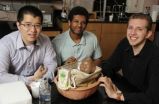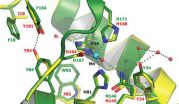(Press-News.org) The over-the-counter anti-inflammatory drug naproxen may also exhibit antiviral activity against influenza A virus, according to a team of French scientists. The finding, the result of a structure-based investigation, is published online ahead of print in the journal Antimicrobial Agents and Chemotherapy.
New influenza vaccines must be developed annually, because the surface proteins they target mutate rapidly, the way cars used to get a whole new look every year. The researchers, led by Anny Slama-Schwok of the Institut National de la Recherche Agronomique, Jouy en Josas, France, found a much more stable, reliable target for anti-influenza activity. The so-called ribonucleoprotein complexes are necessary for replication, and the researchers realized they could target the nucleoprotein, preventing assembly of the complexes. Because of its vital function, the nucleoprotein is highly conserved, making it a good potential target for antiviral drugs.
The nucleoprotein's three dimensional structure, solved in 2006, provided the basis for searching for new drugs that could interfere with its action. The researchers did a virtual screening within the Sigma-Aldrich online catalog of biochemicals. That screening identified Naproxen, better known as the over-the-counter pain reliever Aleve, and as expected, it bound to the nucleoprotein, and impeded RNA binding, says Slama-Schwok. In further testing, it reduced the viral load in cells infected with H1N1 and H3N2 influenza A virus, and in mice it demonstrated a therapeutic index against influenza A that was superior to that of any other anti-inflammatory drug.
Specifically, naproxen blocks the RNA binding groove of the nucleoprotein, preventing formation of the ribonucleoprotein complex, thus taking the vital nucleoproteins out of circulation. The researchers write that naproxen is a lead compound for drug development that could be improved by tweaking the molecule to boost its ability to bind to nucleoprotein.
As an already approved drug, naproxen could become a treatment against influenza relatively quickly, the researchers write. Its status as a non-steroidal anti-inflammatory drug (NSAID), which inhibits the COX-2 pathway, as well as an antiviral would boost its efficacy.
###
A copy of the manuscript can be found online at http://bit.ly/asmtip0313a. Formal publication of the article is scheduled for the May 2013 issue of Antimicrobial Agents and Chemotherapy.
(N. Lejal, B. Tarus, E. Bouguyon, S. Chenavas, N. Bertho, B. Delmas, R.W.H. Ruigrok, C. Di Primo, A. Slama-Schwok, 2013. Structure-based discovery of the novel antibviral properties of Naproxen against the nucleoprotein of influenza A virus. Antim. Agents Chemother. Online ahead of print 4 March 2013 ,doi:10.1128/AAC.02335-12)
Antimicrobial Agents and Chemotherapy is a publication of the American Society for Microbiology (ASM). The ASM is the largest single life science society, composed of over 39,000 scientists and health professionals. Its mission is to advance the microbiological sciences as a vehicle for understanding life processes and to apply and communicate this knowledge for the improvement of health and environmental and economic well-being worldwide.
END
Dartmouth researchers have taken an important step in the ongoing battle against secondhand tobacco smoke. They have pioneered the development of a breakthrough device that can immediately detect the presence of secondhand smoke and even third-hand smoke.
Smaller and lighter than a cellphone and about the size of a Matchbox car, the device uses polymer films to collect and measure nicotine in the air. A sensor chip then records the data on an SD memory card. The technology is described in a new study appearing in the journal Nicotine and Tobacco Research.
"We have ...
Decades of research and three large-scale clinical trials have so far failed to yield an effective HIV vaccine, in large part because the virus evolves so rapidly that it can evade any vaccine-induced immune response.
Researchers from the Ragon Institute of MGH, MIT and Harvard University have now developed a new approach to vaccine design that may allow them to cut off those evolutionary escape routes. The researchers have developed and experimentally validated a computational method that can analyze viral protein sequences to determine how well different viral strains ...
Researchers from the University of Alberta are leading a charge among Canada's obesity experts and calling on the federal government to ban food and beverage ads that target children.
Kim Raine, a professor with the Centre for Health Promotion Studies in the School of Public Health at the U of A, says governments need to take action to stem the rising obesity epidemic. The only exception to a proposed food and beverage marketing ban would be for approved public health campaigns that promote healthy eating.
"Restricting marketing is not going to be a cure for childhood ...
The discovery of the Rosetta Stone resolved a longstanding puzzle, permitting the translation of Egyptian hieroglyphs into Ancient Greek.
John Chaput, a researcher at Arizona State University's Biodesign Institute has been hunting for a biological Rosetta Stone—an enzyme allowing DNA's 4-letter language to be written into a simpler (and potentially more ancient) molecule that may have existed as a genetic pathway to DNA and RNA in the prebiotic world.
Research results, which recently appeared in the Journal of the American Chemical Society, demonstrate that DNA sequences ...
PROVIDENCE, R.I. [Brown University] — A key advance, newly reported by chemists from Brown and Yale Universities, could lead to a cheaper and more sustainable way to make acrylate, an important commodity chemical used to make materials from polyester fabrics to diapers.
Chemical companies churn out billions of tons of acrylate each year, usually by heating propylene, a compound derived from crude oil. "What we're interested in is enhancing both the economics and the sustainability of how acrylate is made," said Wesley Bernskoetter, assistant professor of chemistry at ...
When babies are deprived of oxygen before birth, brain damage and disorders such as cerebral palsy can occur. Extended cooling can prevent brain injuries, but this treatment is not always available in developing nations where advanced medical care is scarce. To address this need, Johns Hopkins undergraduates have devised a low-tech $40 unit to provide protective cooling in the absence of modern hospital equipment that can cost $12,000.
The device, called the Cooling Cure, aims to lower a newborn's temperature by about 6 degrees F for three days, a treatment that has been ...
GAINESVILLE, Fla. — A new University of Florida study of nearly 5,000 Haiti bird fossils shows contrary to a commonly held theory, human arrival 6,000 years ago didn't cause the island's birds to die simultaneously.
Although many birds perished or became displaced during a mass extinction event following the first arrival of humans to the Caribbean islands, fossil evidence shows some species were more resilient than others. The research provides range and dispersal patterns from A.D. 600 to 1600 that may be used to create conservation plans for tropical mountainous regions, ...
Scientists have confirmed that the pathogen that causes Lyme Disease—unlike any other known organism—can exist without iron, a metal that all other life needs to make proteins and enzymes. Instead of iron, the bacteria substitute manganese to make an essential enzyme, thus eluding immune system defenses that protect the body by starving pathogens of iron.
To cause disease, Borrelia burgdorferi requires unusually high levels of manganese, scientists at Johns Hopkins University (JHU), Woods Hole Oceanographic Institution (WHOI), and the University of Texas reported. Their ...
The American Society for Radiation Oncology (ASTRO) has issued a new white paper, "Enhancing the role of case-oriented peer review to improve quality and safety in radiation oncology: Executive Summary," that recommends increased peer review within the radiation therapy treatment process and among members of the radiation oncology team in order to increase quality assurance and safety, according to the manuscript published as an article in press online in Practical Radiation Oncology (PRO), the official clinical practice journal of ASTRO. The executive summary and supplemental ...
Martin Gartzman sat in his dentist's waiting room last fall when he read a study in Education Next that nearly brought him to tears.
A decade ago, in his former position as chief math and science officer for Chicago Public Schools, Gartzman spearheaded an attempt to decrease ninth-grade algebra failure rates, an issue he calls "an incredibly vexing problem." His idea was to provide extra time for struggling students by having them take two consecutive periods of algebra.
Gartzman had been under the impression that the double-dose algebra program he had instituted had ...




